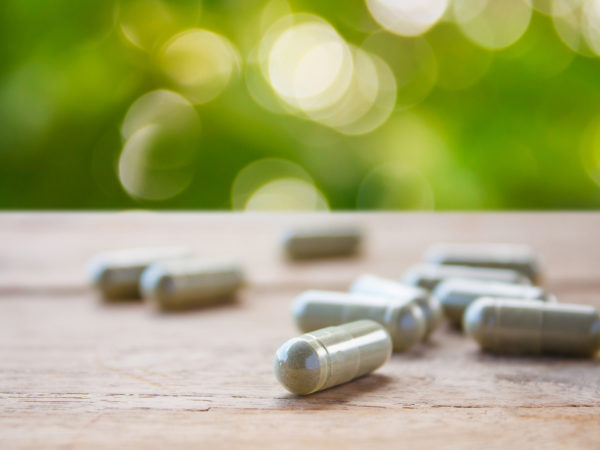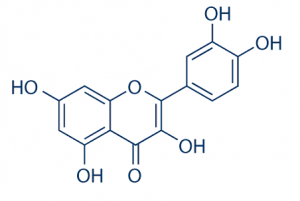Quercetin & Covid-19

Quercetin is a bioflavanoid originally identified in oak leaves/bark (Quercus robur) hence the name, however it is found in a wide variety of plants including many common foods, herbs and spices.
Quercetin has anti-oxidant, anti-inflammatory, antiviral, antiallergic, antiplatelet (anticoagulant), and vasodilatory properties.
It has been shown that it can kill cancer cells, help, control blood sugar levels and prevent heart disease, but more recently it has been extensively investigated for its properties against Covid-19 in a variety of clinical studies.
C15H10O7

Sars-CoV-2 / Covid-19
Quercetin is proven to inhibit SARS-CoV-2 binding to the human cell via virus-specific protease and viral S-protein S-human ACE-2 interface 1 (Nair et al., 2002; Uchide et al., 2011; Gormaz et al., 2015) and a potential anti-COVID-19 drug due to its inhibitory effect on platelet aggregation and mast cell activation (Ross JA and Kasum CM, 2002). (1)
Quercetin has a theoretical, but significant, capability to interfere with SARS-CoV-2 replication, with the results showing this to be the fifth best compound out of 18 candidates. (2)
Clinical trials have shown that Quercetin reduces both hospitalizations and deaths from Covid-19, including frequency and length of hospitalisation and need for oxygen therapy.
Quercetin originally attracted attention as a potential treatment for Covid-19 because it is a zinc ionophore which means it carries zinc into your cells, in a similar way to drugs such as hydroxychloroquine which had been demonstrated to be effective treatment for Covid-19.
Zinc is known to be vital for your immune system especially against viral infections.
In fact, one now well know New York doctor, Vladimir Zelenko, who had been successfully treating Covid patients from the start of the pandemic with hydroxychloroquine and ivermectin, had to switch to replacing them with quercetin when the FDA banned the use of these drugs, as they threatened to undermine the profits that could be made from promoting vaccines as the only viable solution for Sars-Cov2.
Quercetin inhibits spike proteins from binding to ACE2 receptors, so blocking the virus from entering cells, as well as directly blocking viral proteins necessary for replication.
It has also been shown to inhibit the release of inflammatory cytokines, which could help alleviate infection-related symptoms and suppress excessive inflammatory responses from occurring. Its antioxidant effects may also help prevent tissue damage caused by scavenging free radicals, thereby aiding in the recovery process of viral infections.
Antiviral properties
Quercetin has been studied since the mid 80’s for its general antiviral properties which have demonstrated it can inhibit seasonal cold and flu viruses, but also herpes simplex, polio type-1, parainfluenza, respiratory syncytial virus (RSV), dengue virus, and hepatitis B & C.
Antioxidant properties
By reducing oxidative damage quercetin has been shown to reduce the risk of secondary bacterial infections which are the main cause of influenza related deaths. It has been demonstrated to neutralise pneumolysin (PLY) a toxin released by Streptococcus pneumoniae. This bacteria is responsible for pneumonia, but also some ear and sinus infections, meningitis and some types of sepsis. In fact, bearing in mind growing antibiotic resistance of S.pneumoniae, quercetin may provide a viable alternative treatment for pneumonia.
Antiinflammatory properties
Quercetin can inhibit, down regulate or suppress a wide range of inflammatory pathways, including stabilizing mast cells, inhibiting the production of inflammatory enzymes or cytokines, such as tumor necrosis factor (TNF-a), interleukin (IL-1a) and histamine. (3)
Safety & Dosage
Quercetin has been demonstrated to be a safe substance to take and the studies used 400-1,000 mg per day for upto 30 days from onset of symptoms.
Sources of quercetin
Quercetin is widely abundant in the plant world and found in many traditional herbal remedies in which it probably plays a contributory role in their medicinal effects.
Commercial quercetin supplements are typically sourced from quercetin rich herbs such the root of the Chinese medicinal herb Sophora flavescens or Sophora japonica. Known as Ku Shen it was traditionally used to treat Damp-Heat Accumulations which typically include inflammatory and infectious conditions, including fever, asthma, bronchitis, dysentery, eczema.
Quercetin can also be found in relative abundance in a variety of common foods. See table below;
| Foods richest in quercetin | (mg/100g) |
|---|---|
| Capers 234 | Bee pollen 20.95 |
| Dill 79 Fennel leaves 46.8 Oregano 42 |
Cocoa 20 |
| Onions 45 Yellow onions 41.9 Red onions 39 Spring onions 30.6 Chives 10.4 Leeks 0.9 |
Elderberries 27 Cherries 17 Cranberries 15 Blueberries 15 Goji berries 14 |
| Carob flour 38.8 | Asparagus 15 Broccoli 14 |
| Radicchio 31.5 Red lettuce 30 Green lettuce 14 |
Apple peel 19 Apples 4 |
| Watercress 30 Spinach 27 Kale 23 Okra 21 |
Black tea 2.5 Red wine 3 |
References;
1. Treatment of COVID-19 patients with quercetin: a prospective, single center, randomized, controlled trial
ÖNAL H, et al . Turk J Biol. 2021: 45(4): 518-529
https://www.ncbi.nlm.nih.gov/pmc/articles/PMC8573830/#
2. A role for quercetin in coronavirus disease 2019 (COVID-19)
Derosa G. et al. Phytother Res. 2021 Mar;35(3):1230-1236.
https://pubmed.ncbi.nlm.nih.gov/33034398/
3. Two New Studies Show Quercetin Improves COVID Outcomes
Posted on October 14, 2021 by flybynews
Analysis by Dr. Joseph Mercola
https://flybynews.wordpress.com/2021/10/14/two-new-studies-show-quercetin-improves-covid-outcomes/
4. Quercetin and Vitamin C: An Experimental, Synergistic Therapy for the Prevention and Treatment of SARS-CoV-2 Related Disease (COVID-19)
Biancatelli et al Front. Immunol., 19 June 2020 | https://doi.org/10.3389/fimmu.2020.01451
